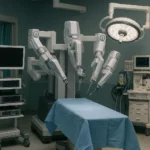Retinoblastoma Treatment: Symptoms, Diagnosis & Advanced Care
When we think of cancer, our minds often go to lung, breast, or colon cancer. But what many overlook is that cancer can affect even the youngest among us—sometimes just months after birth. One such rare yet critical condition is retinoblastoma, a type of eye cancer that primarily affects children, making timely retinoblastoma treatment essential.
For families, it’s not just a medical emergency—it becomes an emotional one. Understanding retinoblastoma—its causes, symptoms and treatment options—can make all the difference in early detection and saving a child’s vision or even their life. This blog is crafted to be both informative and compassionate, offering clarity and support for anyone seeking to understand or navigate the challenges of this devastating diagnosis.
Understanding Retinoblastoma: The Urgency of Timely Retinoblastoma Treatment
Retinoblastoma is a pediatric cancer that forms in the retina, the light-sensitive layer at the back of the eye. Most cases are diagnosed in children under the age of 5. The disease is infrequent, but when it does occur, it will progress quickly and can be immediately life-threatening without treatment.
This eye cancer may be unilateral: affecting one eye (unilateral) or both eyes (bilateral). Because it’s dangerous for the life of the child, retinoblastoma may severely hamper his or her sight. It may eventually metastasize to the brain, spine and other body parts at the last stage if retinoblastoma is left untreated.
Why Retinoblastoma Treatment Is Needed in Early Childhood?
The most common reason for retinoblastoma in children is usually the mutation of the RB1 gene. The very normal function of this gene is to produce the protein that regulates the growth of retinal cells. If this gene becomes defective, it takes control over cell growth and leads to cancer.
These mutations in genes can be very much either inherited (hereditary retinoblastoma) or simply acquired (sporadic retinoblastoma). Most of the cases are sporadic. However, the presence of a family history raises the likelihood of the occurrence of this disease as well. Getting insight into the genetic basis tends to help in directing genetic testing and counseling for such families that are considered to be at risk.
Retinoblastoma Symptoms
Drawing attention to certain signs and symptoms of this malignant tumor at an early stage may optimally increase the chances of treatment succeeding. In fact, it is often parents that first notice something not quite right in their child’s eyes—and sometimes just through looking at a photo.
Here are the most common eye cancer symptoms seen in retinoblastoma:
- Leukocoria (White Pupillary Reflex): Often described as a “white glow” in the pupil, which may appear in flash photographs.
- Strabismus (Crossed Eyes or Lazy Eye): A misalignment of the eyes that might suggest vision issues.
- Poor Vision: The child may not track objects or respond visually to light and movement.
- Eye Redness and Swelling: Although less common, inflammation without signs of infection can be a red flag.
- Eye Pain or Irritability: This may indicate increased pressure within the eye or tumor growth.
Immediately after noticing any of these signs, bring the child in for a pediatric ophthalmology evaluation. These signs often tend to be rather obscure and subtly point towards cancer in children.
Diagnosis: How Retinoblastoma is Detected
Once symptoms are recognised, a series of diagnostic tests are conducted to confirm the presence and extent of the disease:
- Ophthalmic Examination: Using specialised instruments to examine the retina under anesthesia.
- Ultrasound and MRI: To determine tumor size and whether it has spread beyond the eye.
- Genetic Testing: Especially important if hereditary retinoblastoma is suspected.
- Bone Marrow Tests and Spinal Tap: Conducted in advanced cases to see if cancer has spread.
Early and accurate diagnosis can be life-saving. The goal is not only to treat the cancer but to preserve as much vision as possible.
Retinoblastoma Treatment: A Multimodal Approach
The tenor of retinoblastoma treatment has changed significantly for the better throughout the years. This condition allows for over 90% survival rates in children in developed countries with early detection and good medical advances.
The treatment plan is personalised for each child based on the size and location of the tumors, whether one or both eyes are involved and whether the cancer has spread beyond the eye.
1. Chemotherapy
- Systemic Chemotherapy: Administered through the bloodstream to shrink tumors.
- Intra-arterial Chemotherapy: Delivers the drug directly into the artery feeding the eye, minimizing side effects.
- Intravitreal Chemotherapy: Injected directly into the eye to target vitreous seeding.
2. Laser Therapy (Photocoagulation)
- Uses heat from a laser to destroy small tumors.
3. Cryotherapy
- Freezes and kills cancer cells in small tumors near the edge of the retina.
4. Radiation Therapy
- Though less commonly used now, it’s still effective in certain cases.
5. Surgery
- In severe cases where doctors cannot save the eye, they may need to perform enucleation (remove the eye) to prevent the spread of cancer.
Eye cancer treatment strategies aim at vision saving and improving the quality of life. Holistic care has been possible by a multidisciplinary team of oncologists, ophthalmologists, geneticists and counselors.
Prognosis and Long-Term Success of Retinoblastoma Treatment
Thanks to early detection and improved therapies, the prognosis for retinoblastoma is very good when caught early. In countries with access to modern treatments, the survival rate exceeds 90%.
However, the long-term impact depends on factors like:
- Whether both eyes were affected
- The extent of vision loss
- Psychological effects from treatment or disfigurement
- Risk of developing secondary cancers (especially in hereditary cases)
Children who have had retinoblastoma need regular follow-ups throughout life, not just to detect recurrence but also to monitor for other types of pediatric cancer or side effects of treatment.
Supporting the Emotional Wellbeing of Families
Apart from the medical journey, families have to cross the emotional aspect, which would be as heavy as the former. Eye cancer may prove overwhelming for a child; it often overwhelms the patient, whereas the loved ones may feel guilt, anxiety and helplessness; the child may feel confusion or fear, especially losing sight or undergoing surgery.
Different support services including psychological counseling, vision therapy and support groups may form a significant difference among families. Many non-profit organisations support families coping with childhood cancer by connecting them with others who have walked on the same path.
Genetic Counseling and Preventive Steps
In hereditary cases, genetic counseling is crucial. If a parent carries the mutated RB1 gene, future children may be at risk. Genetic testing can identify carriers and prenatal or newborn screening allows for early monitoring.
Families can benefit from:
- Early eye exams for at-risk infants
- Genetic counseling before having more children
- Emotional support and awareness campaigns
Proactive steps can change outcomes dramatically by allowing for earlier diagnosis and timely retinoblastoma treatment.
Life After Retinoblastoma
Surviving retinoblastoma is only the beginning of a new journey. Children may need:
- Visual rehabilitation
- Prosthetic eye fittings (if eye removal was necessary)
- Special education support in school
So, many children, despite the adversities, do grow into healthy and productive adults. Given proper support, families will transfer their trauma into strength, leading them to advocate for eye health and pediatric cancer awareness.
What Research Says About Retinoblastoma
- Studies show that over 90% of children with retinoblastoma survive when diagnosed early and treated effectively
- Ongoing research focuses on gene therapy and targeted molecular treatments to improve survival and reduce long-term side effects
- Personalised treatment based on RB1 gene mutations and retinoblastoma protein profiling is revolutionizing pediatric oncology
- Global collaborations have helped create screening protocols, especially for families with hereditary risk
- New research also emphasizes mental health care for children and parents post-treatment
The future of retinoblastoma treatment is promising — and every step forward is saving more children each year.
Why India for Retinoblastoma Treatment?
India has become a leading destination for global patients seeking quality and affordable cancer care. Here’s why:
- World-Class Pediatric Oncology Centers with advanced infrastructure
- Highly Experienced Doctors, including leading pediatric oncologists and ophthalmologists
- Cutting-Edge Technologies like intra-arterial chemotherapy, laser photocoagulation, and genetic testing
- Cost-Effective Treatment compared to Western countries without compromising quality
- Shorter Waiting Times, allowing faster diagnosis and immediate care
- Comprehensive Child Care including vision rehabilitation and psychological support
Choose Regimen Healthcare for Expert Retinoblastoma Treatment Support
At Regimen Healthcare, we understand how difficult this journey is for parents. That’s why we’re more than just a facilitator — we’re a compassionate care partner.
- We connect you with the best hospitals and top pediatric oncologists in India
- We help with early diagnosis, doctor opinions, and second opinions
- We offer end-to-end support – from visa and travel to treatment and aftercare
- Our team speaks your language and understands your cultural needs
- We have helped hundreds of families globally navigate eye cancer treatment with clarity and hope
Conclusion: Hope, Healing, and the Power of Early Retinoblastoma Treatment
Retinoblastoma serves as a powerful reminder that eye cancer can attack the very young. But with early diagnosis, advanced treatment and emotional fortitude, these children can and do survive.
Awareness encompasses everything from being alert to the symptoms of retinoblastoma to understanding the role of the retinoblastoma protein in cell cycle regulation. Moreover, it empowers families to act with speed, get to the right kind of care, and ultimately protect their child through the long and arduous path of recovery.
Most importantly, we must always remember that beyond every diagnosis is a child with so much promise and hope, whose future can still shine as brightly as their eyes once did.
If you or someone you love suspects eye cancer symptoms in a child — don’t wait.
At Regimen Healthcare, we’re here to guide you through every step of the process, from diagnosis to recovery. To begin with, our expert care team will connect you with the top pediatric oncology hospitals in India, ensure quick appointments, assist with travel and stay, and, above all, support your family with compassion.
👉 Book a free consultation today and take the first step toward healing.
📞 Contact our care team at +91-9310356465 or visit www.regimenhealthcare.com
FAQs
1. Can retinoblastoma be cured?
Yes, especially if caught early. Treatment success rates are very high in developed countries.
2. Is retinoblastoma painful?
In early stages, it often isn’t. But advanced cases may cause discomfort, redness, or swelling.
3. Can adults get Retinoblastoma Treatment?
It’s extremely rare. The condition almost exclusively affects young children.
4. What happens after the eye is removed?
A prosthetic eye is fitted. Children adapt well and can live normal lives with it.
5. Can children with hereditary retinoblastoma develop other cancers?
Yes, they are at a slightly higher risk for other types of cancer later in life, especially bone or soft tissue cancers.






